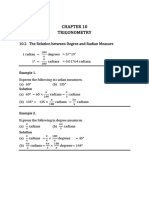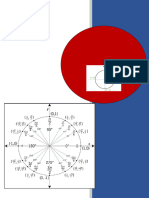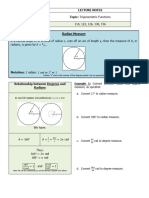Radian s
Radian s
Uploaded by
enan.islam2005Copyright:
Available Formats
Radian s
Radian s
Uploaded by
enan.islam2005Copyright
Available Formats
Share this document
Did you find this document useful?
Is this content inappropriate?
Copyright:
Available Formats
Radian s
Radian s
Uploaded by
enan.islam2005Copyright:
Available Formats
Radians Cheat Sheet Pure Year 2
Radians are simply another way to measure angles. In many areas of mathematics and physics, using radians as opposed to Exam-style question
degrees turns out to be much more convenient. For example, the arc length formula which we will cover soon is greatly We will now go through an exam-style question where you can be expected to use what you have learnt so far.
simplified by using radians. Solving trigonometric equations
You also need to be able to solve trigonometric equations using radians. The method is exactly the same as with Example 5: The diagram shows the cross section 𝐴𝐵𝐶𝐷 of a glass prism. 𝐴𝐷 = 𝐵𝐶 = 4 𝑐𝑚 and both are at right
degrees, but you need to give your answers in radians. angles to 𝐷𝐶. 𝐴𝐵 is the arc of a circle, centre O and radius 6 cm. Given that ∠𝐴𝑂𝐵 = 2𝜃 radians, and
Using Radians that the perimeter of the cross section is 2(7 + 𝜋) cm,
To convert between radians and degrees, you can use the fact that:
▪ If the interval is given in radians, then you should leave your answers in radians.
180° 𝜋
▪ 1 𝑟𝑎𝑑𝑖𝑎𝑛 = Let’s go through an example. a) Show that (2𝜃 + 2𝑠𝑖𝑛𝜃 − 1) = 3 .
It helps to remember the following angles in radians: Example 2: Solve 8𝑡𝑎𝑛2𝑥 = 7 in the interval 0 ≤ 𝑥 ≤ 2. b) Verify that 𝜃 = 6 ,
𝜋
𝜋 𝜋 The interval is given in radians, so we must make sure we work in radians. Don’t forget to switch to
▪ 30° = ▪ 90° = c) Find the area of the cross-section.
6 2 the radians mode on your calculator.
d) Show that when 𝑥 is small,
▪ 45° = ▪ 180° = 𝜋 𝑡𝑎𝑛2𝑥 =
7
S A
4 8
𝜋(2(1−𝑐𝑜𝑠𝑥)−𝑠𝑖𝑛 2 𝑥+𝑠𝑖𝑛𝑥−1) 1
▪ 60° =
▪ 360° = 2𝜋 7
the expression
12𝑡𝑎𝑛𝑥−12
≈ 𝜃.
2
3 2𝑥 = arctan (8) = 0.719
0.719
You can be asked to sketch trigonometric functions giving your angles in radians, so you should be very efficient at Using CAST or a graphical method, our solutions are:
converting between radians and degrees. 0.719
2𝑥 = 0.719, + 0.719
You also need to learn the exact value of certain trigonometric ratios given in radians: ⇒ 2𝑥 = 0.719, 3.86
∴ 𝑥 = 0.36, 1.93 are our final solutions.
T C a) Perimeter = 4 + 4 + 𝐷𝐶 + 𝐴𝐵
𝜋 1 𝜋 √3 𝜋 √3 𝐴𝐵 = 𝑟𝜃 = 6 × 2𝜃 = 12𝜃
▪ 𝑠𝑖𝑛 ( ) = ▪ 𝑐𝑜𝑠 ( ) = ▪ 𝑡𝑎𝑛 ( ) =
6 2 6 2 6 3
Using trigonometry, we can see that 𝐷𝐶 = 2(6𝑠𝑖𝑛𝜃)
𝜋 √3 𝜋 1 𝜋 As you can see, the procedure is still the same. You just need to be comfortable with using radians. ∴ Perimeter = 12𝑠𝑖𝑛𝜃 + 8 + 12𝜃 = 2(7 + 𝜋)
▪ 𝑠𝑖𝑛 ( ) = ▪ 𝑐𝑜𝑠 ( ) = ▪ 𝑡𝑎𝑛 ( ) = √3
3 2 3 2 3
𝜋
Rearranging: 12𝜃 + 12𝑠𝑖𝑛𝜃 − 6 = 2𝜋
𝜋 √2
▪ 𝑠𝑖𝑛 ( ) =
𝜋 √2
▪ 𝑐𝑜𝑠 ( ) = ▪ 𝑡𝑎𝑛 ( ) = 1 Small angle approximations 𝜋
Dividing by 6 gives: 2𝜃 + 2𝑠𝑖𝑛𝜃 − 1 = 3 as required.
4 2 4 2 4
When 𝜃 is close to zero and measured in radians, we can use the following approximations:
▪ 𝑠𝑖𝑛𝜃 ≈ 𝜃
Arc length 𝜃2 𝜋
▪ 𝑐𝑜𝑠𝜃 ≈ 1 − b) We just need to plug in 𝜃 = 6 to the 𝐿𝐻𝑆 and check it is equal to the RHS.
To find the arc length 𝑙 of a sector of a circle, we can use the formula 2
▪ 𝑡𝑎𝑛𝜃 ≈ 𝜃 𝜋 𝜋 𝜋 𝜋
⇒ 2 ( 6 ) + 2𝑠𝑖𝑛 6 − 1 = 3 + 1 − 1 = 3 = 𝑅𝐻𝑆 so 𝜃 = 6 .
𝜋
▪ 𝑙 = 𝑟𝜃
where 𝑟 is the radius of the circle and 𝜃 is the angle c) A𝑟𝑒𝑎 𝑜𝑓 𝑐𝑟𝑜𝑠𝑠 𝑠𝑒𝑐𝑡𝑖𝑜𝑛 = 𝐴𝑟𝑒𝑎 𝑜𝑓 𝑟𝑒𝑐𝑡𝑎𝑛𝑔𝑙𝑒 𝐴𝐵𝐶𝐷 – 𝐴𝑟𝑒𝑎 𝑜𝑓 𝑠𝑒𝑔𝑚𝑒𝑛𝑡 𝐴𝐵
contained in the sector, given in radians. To see why these are good approximations, we can graph each of the functions against their approximations.
Areas
To find the area of a sector, shown in blue, we can use the formula
1
𝑦 = 𝑐𝑜𝑠𝑥 𝑦 = 𝑠𝑖𝑛𝑥 𝑦 = 𝑡𝑎𝑛𝑥 𝜋
▪ 𝐴 = 2 𝑟2𝜃 Area of rectangle ABCD = 4 × 12𝑠𝑖𝑛 ( 6 ) = 24
𝑥2 𝑦=𝑥 𝑦=𝑥
𝑦 =1− 1 1 𝜋 𝜋 𝜋 √3
2 Area of segment AB = (𝑟)2 (2𝜃 − 𝑠𝑖𝑛2𝜃) = (6)2 ( − 𝑠𝑖𝑛 ) = 18 ( − ) = 6𝜋 − 9√3
2 2 3 3 3 2
To find the area of a segment, shown in yellow, we can use the formula
We can see that around 𝑥 = 0, the graphs are almost identical. This explains why these approximations are
1 suitable for 𝑥 close to zero. There is no set range for which these approximations are to be used. ⇒ 𝐴𝑟𝑒𝑎 𝑜𝑓 𝑐𝑟𝑜𝑠𝑠 𝑠𝑒𝑐𝑡𝑖𝑜𝑛 = 24 − (6𝜋 − 9√3) = 24 + 9√3 − 6𝜋
▪ 𝐴 = 2 𝑟 2 (𝜃 − 𝑠𝑖𝑛𝜃)
4𝑐𝑜𝑠3𝜃−2+5𝑠𝑖𝑛𝜃
1 Example 3: When 𝜃 is close to zero, show that can be rewritten as 9𝜃 + 2.
recall that the area of a triangle is 𝑎𝑏𝑠𝑖𝑛𝜃 1−𝑠𝑖𝑛2𝜃 e) Starting with the numerator:
2
You need to be able to apply the above formulae to problems. Inputting our approximations:
𝑥2
π(2(1 − 𝑐𝑜𝑠𝑥) − 𝑠𝑖𝑛2 𝑥 + 𝑠𝑖𝑛𝑥 − 1) ≈ 𝜋 [2 (1 − (1 − 2
)) − (𝑥)2 + 𝑥 − 1]
(3𝜃)2
Example 1: In the diagram below, AB is the diameter of a circle centre O of radius r cm and ∠𝐵𝑂𝐶 = 𝜃 ⇒ 4𝑐𝑜𝑠3𝜃 − 2 + 5𝑠𝑖𝑛𝜃 ≈ 4 (1 − ) − 2 + 5𝜃 = 2 + 5𝜃 − 18𝜃 2
2
radians. Given that the area of △ 𝐶𝑂𝐵 is equal to that of the shaded segment, show that
𝑥2
𝜃 + 2𝑠𝑖𝑛𝜃 = . ⇒ 1 − 𝑠𝑖𝑛2𝜃 ≈ 1 − 2𝜃 ⇒ 𝜋 [2 (( 2 )) − (𝑥)2 + 𝑥 − 1] = 𝜋[𝑥 2 − 𝑥 2 + 𝑥 − 1] = 𝜋(𝑥 − 1)
1
Area 𝐶𝑂𝐵 = 𝑟 2 𝑠𝑖𝑛𝜃 (area of a triangle, 𝑂𝐶 = 𝑂𝐵 = 𝑟) 4𝑐𝑜𝑠3𝜃−2+5𝑠𝑖𝑛𝜃 2+5𝜃−18𝜃2 (1−2𝜃)(2+9𝜃)
Now considering the denominator:
2 ∴ 1−𝑠𝑖𝑛2𝜃
≈ 1−2𝜃
= 1−2𝜃
= 2 + 9𝜃 as required.
1
Shaded segment = 𝑟 2 ((𝜋 − 𝜃) − sin (𝜋 − 𝜃)) Once you substitute your approximations, it becomes a matter of simplifying your expression to achieve the 12𝑡𝑎𝑛𝑥 − 12 ≈ 12𝑥 − 12 = 12(𝑥 − 1)
2
desired result.
1 1 𝜋(2(1−𝑐𝑜𝑠𝑥)−𝑠𝑖𝑛 2 𝑥+𝑠𝑖𝑛𝑥−1) 𝜋(𝑥−1) 𝜋
Equating: 2 𝑟 2 𝑠𝑖𝑛𝜃 = 2 𝑟 2 ((𝜋 − 𝜃) − sin(𝜋 − 𝜃)) ∴ = =
Example 4: When 𝜃 is close to zero, find the approximate value of 𝑐𝑜𝑠 𝜃 − 𝑠𝑖𝑛 𝜃. 4 4 12𝑡𝑎𝑛𝑥−12 12(𝑥−1) 12
Notice that sin(𝜋 − 𝜃) = sin(𝜃), 𝜋
1 ⇒ 𝑐𝑜𝑠 4 𝜃 − 𝑠𝑖𝑛4 𝜃 = (𝑐𝑜𝑠 2 𝜃 + 𝑠𝑖𝑛2 𝜃)(𝑐𝑜𝑠 2 𝜃 − 𝑠𝑖𝑛2 𝜃) difference of two squares But in part b, we verified 𝜃 = 6 .
dividing through by 2 𝑟 2 and rearranging: 𝑠𝑖𝑛𝜃 = 𝜋 − 𝜃 − 𝑠𝑖𝑛𝜃
= (1)(𝑐𝑜𝑠 2 𝜃 − 𝑠𝑖𝑛2 𝜃) using 𝑐𝑜𝑠 2 𝜃 + 𝑠𝑖𝑛2 𝜃 = 1
∴ 𝜃 + 2𝑠𝑖𝑛𝜃 = 𝜋 as required ⇒ [1 − 𝑠𝑖𝑛2 𝜃 − 𝑠𝑖𝑛2 𝜃] = 1 − 2𝑠𝑖𝑛2 𝜃 = 1 − 2𝜃 2 𝜋 1 𝜋 𝜋(2(1−𝑐𝑜𝑠𝑥)−𝑠𝑖𝑛 2 𝑥+𝑠𝑖𝑛𝑥−1) 1
= × hence. ≈ 𝜃 as required.
12 2 6 12𝑡𝑎𝑛𝑥−12 2
https://bit.ly/pmt-cc
https://bit.ly/pmt-edu https://bit.ly/pmt-cc
You might also like
- Inventories:: True or FalseDocument8 pagesInventories:: True or FalseXiena0% (1)
- Radian SDocument1 pageRadian StawananyashaNo ratings yet
- Ch.5 RadiansDocument1 pageCh.5 RadiansNikitha SomaratneNo ratings yet
- P2 Chp5 RadiansDocument28 pagesP2 Chp5 RadiansWaqas KhanNo ratings yet
- All LESSON Handouts - Chapter 6 RevisedDocument19 pagesAll LESSON Handouts - Chapter 6 Revisedvexiox900No ratings yet
- RadiansDocument31 pagesRadiansstevennaing44No ratings yet
- 5.1 Basic TrigonometryDocument47 pages5.1 Basic TrigonometrymonaNo ratings yet
- Y Sinx y Cosx y TanxDocument16 pagesY Sinx y Cosx y TanxLorraine SabbaghNo ratings yet
- Trigonometry 2022-23 Eng PCDocument68 pagesTrigonometry 2022-23 Eng PCShaileshNamdeoNo ratings yet
- Gmas Plane and Solid GeometryDocument11 pagesGmas Plane and Solid Geometryjonnel batuigasNo ratings yet
- Circles Cheat Sheet DTPDocument5 pagesCircles Cheat Sheet DTPJohnNo ratings yet
- t1 - Trigonometric Functions - 1Document23 pagest1 - Trigonometric Functions - 1utpNo ratings yet
- Grade 10 Chapter 10Document56 pagesGrade 10 Chapter 10Kaung KhantNo ratings yet
- Igcse FM: Trigonometry IIDocument28 pagesIgcse FM: Trigonometry IITravel Unlimited100% (1)
- POINTERS TO REVIEW IN PRECALCULUS Quarter 2Document3 pagesPOINTERS TO REVIEW IN PRECALCULUS Quarter 2YonneNo ratings yet
- Module Sabah Add Math f5Document296 pagesModule Sabah Add Math f5LIM YAN JOE MoeNo ratings yet
- PRECALCULUS Module 4 10 12Document56 pagesPRECALCULUS Module 4 10 12emNo ratings yet
- Section 3: Radians: AQA Core 2 TrigonometryDocument1 pageSection 3: Radians: AQA Core 2 TrigonometrywolfretonmathsNo ratings yet
- Compound Angle Workbook 1684260269770Document12 pagesCompound Angle Workbook 1684260269770shlokshukla280300No ratings yet
- Pre Calculus Q4 Week 1 2 Angles in A Unit CircleDocument24 pagesPre Calculus Q4 Week 1 2 Angles in A Unit Circleyuhikurenai6524No ratings yet
- Department of Education: Republic of The PhilippinesDocument40 pagesDepartment of Education: Republic of The PhilippinesMelanie Ibarra CarlosNo ratings yet
- Math g7 m6 Topic A Lesson 3 TeacherDocument12 pagesMath g7 m6 Topic A Lesson 3 TeacherKyra LewisNo ratings yet
- Lesson 1 Angles in A Unit Circle1Document25 pagesLesson 1 Angles in A Unit Circle1furomiren14No ratings yet
- 01 Angles in A Unit CircleDocument34 pages01 Angles in A Unit Circleellamay050921No ratings yet
- Converting Degrees To RadiansDocument2 pagesConverting Degrees To RadiansDeadly ChillerNo ratings yet
- Trigonometry 2D & 3D Last PushDocument26 pagesTrigonometry 2D & 3D Last PushyonwabasaphoNo ratings yet
- Chapter 15 - Trigonometry in Three DimensionsDocument11 pagesChapter 15 - Trigonometry in Three DimensionsPrisky Jofan SimbarNo ratings yet
- Circular MeasuresDocument17 pagesCircular MeasuresMadhusudan AdhikariNo ratings yet
- Angles and Angular MeasuresDocument9 pagesAngles and Angular MeasuresLNo ratings yet
- Sec 1.3Document5 pagesSec 1.3ryyxd8kmjrNo ratings yet
- GR11 - Application of Area RuleDocument5 pagesGR11 - Application of Area RulediegosblushNo ratings yet
- Precal SLM q2w1-2Document11 pagesPrecal SLM q2w1-2Anjanette RiparipNo ratings yet
- Review Module 1Document5 pagesReview Module 1aljohnbondad121521No ratings yet
- 8 Let Trigonometry - pdf7Document7 pages8 Let Trigonometry - pdf7novey_casioNo ratings yet
- OriginalDocument28 pagesOriginalTushar BadheNo ratings yet
- Trigonometric Functions Last PushDocument27 pagesTrigonometric Functions Last Pushmamburuinnocentia1No ratings yet
- Learning Module in Pre CalculusDocument13 pagesLearning Module in Pre CalculusChristian Anthony SerquiñaNo ratings yet
- 01 Unit Circle and Circular FunctionsDocument21 pages01 Unit Circle and Circular FunctionsJoseph Christopher ButaslacNo ratings yet
- 2.sector CircularDocument2 pages2.sector Circulargroupnkt1No ratings yet
- Trigonometric Identities Last PushDocument14 pagesTrigonometric Identities Last Pushpatiencemampane962No ratings yet
- Spherical Excess ProblemDocument3 pagesSpherical Excess ProblemNicole K. MartinezNo ratings yet
- Pre-Calculus Week VIII - Unit CircleDocument32 pagesPre-Calculus Week VIII - Unit CircleSam MNo ratings yet
- QUARTER 2 Worksheets 1 2 and 3 TrigonometryDocument4 pagesQUARTER 2 Worksheets 1 2 and 3 Trigonometrypaulmatthewrefugio.lsdNo ratings yet
- SMILE Learner S Packet Q2 Week 1Document9 pagesSMILE Learner S Packet Q2 Week 1Leizel TicoyNo ratings yet
- PRE CALCULUS 2ndQ SLMDocument45 pagesPRE CALCULUS 2ndQ SLMWilmar RonioNo ratings yet
- Module 3 - Lesson 1 - Angle MeasureDocument50 pagesModule 3 - Lesson 1 - Angle MeasureGavriel Tristan Vital100% (1)
- Handout 02 - Geometry and TrigonometryDocument16 pagesHandout 02 - Geometry and TrigonometryMohamed NaleemNo ratings yet
- G11 Pre-Cal Q2-1Document5 pagesG11 Pre-Cal Q2-1johnkevinespanola54No ratings yet
- Trigonometry Manual FinalDocument67 pagesTrigonometry Manual Finalun47542No ratings yet
- Circular Measure Notes 2012Document5 pagesCircular Measure Notes 2012C Dzirutwe100% (1)
- Chapter 03Document35 pagesChapter 03Christina Corazon GoNo ratings yet
- Trigonometry 2D & 3D Revision BookletDocument26 pagesTrigonometry 2D & 3D Revision Bookletoratilemabusela588No ratings yet
- Trigonometry Jeemain - GuruDocument15 pagesTrigonometry Jeemain - Guruparamarthasom1974No ratings yet
- 5 PDFDocument56 pages5 PDFdNo ratings yet
- Grade 10 Maths Unit-5Document81 pagesGrade 10 Maths Unit-5singtendenelaNo ratings yet
- Book For Module 5Document44 pagesBook For Module 5antonio.sulayNo ratings yet
- Grade10 Quarter 2 Week 5 CompetencyDocument8 pagesGrade10 Quarter 2 Week 5 CompetencyMartin Jess ChavezNo ratings yet
- DOC-20240604-WA0003.Document24 pagesDOC-20240604-WA0003.smarties.stuffz2007No ratings yet
- MathsTraks: Geometry: A Collection of Blackline Masters for ages 11-14From EverandMathsTraks: Geometry: A Collection of Blackline Masters for ages 11-14No ratings yet
- A-level Maths Revision: Cheeky Revision ShortcutsFrom EverandA-level Maths Revision: Cheeky Revision ShortcutsRating: 3.5 out of 5 stars3.5/5 (8)
- Absolute Return Letter The Productivity ConundrumDocument10 pagesAbsolute Return Letter The Productivity ConundrumaaquibnasirNo ratings yet
- People Vs PaguntalanDocument22 pagesPeople Vs Paguntalanabigael severinoNo ratings yet
- Alfa Laval JWP16CDocument4 pagesAlfa Laval JWP16CdhlinvaNo ratings yet
- Doctrine of The MayaDocument153 pagesDoctrine of The Mayaedward prindleNo ratings yet
- Knowledge and Perception of Students Regarding IslamicDocument16 pagesKnowledge and Perception of Students Regarding IslamicMohamed MustefaNo ratings yet
- Digital-To-Analog Converter - Wikipedia, The Free EncyclopediaDocument8 pagesDigital-To-Analog Converter - Wikipedia, The Free EncyclopediaAnilkumar KubasadNo ratings yet
- Plato Reading Questions/study Guide:: BackgroundDocument3 pagesPlato Reading Questions/study Guide:: BackgroundshigekaNo ratings yet
- Top 100 Engineering Interview QuestionsDocument3 pagesTop 100 Engineering Interview QuestionsHemanth KumarNo ratings yet
- Race of The ZodiacDocument6 pagesRace of The Zodiacduyen.ledynirisNo ratings yet
- Catalogo X10R - 48Document3 pagesCatalogo X10R - 48Walter FormigoniNo ratings yet
- Vacuum Packaging Manual New KorDocument44 pagesVacuum Packaging Manual New KorSameer KhanNo ratings yet
- Plaintiff-Appellee Accused-Appellant: People of The Philippines, Aubrey Enriquez SoriaDocument11 pagesPlaintiff-Appellee Accused-Appellant: People of The Philippines, Aubrey Enriquez SoriaDarla EnriquezNo ratings yet
- Crystal A. Watson: Cell: (340) 642-4739 E-MailDocument2 pagesCrystal A. Watson: Cell: (340) 642-4739 E-Mailapi-295934075No ratings yet
- MCQs in Sports Physiotherapy WithDocument178 pagesMCQs in Sports Physiotherapy WithGargi L K100% (1)
- Chapter 12 - Plate Bending Elements: Learning ObjectivesDocument34 pagesChapter 12 - Plate Bending Elements: Learning ObjectivesVENKATA RANGANADHNo ratings yet
- Breakdown in Solid DielectricsDocument4 pagesBreakdown in Solid DielectricsmadhueeNo ratings yet
- Satan The Prophet A History of Modern Satanism: Massimo IntrovigneDocument62 pagesSatan The Prophet A History of Modern Satanism: Massimo IntrovigneDavid Rios Calcagno100% (1)
- Disocont Tersus Measurement, Control and Supervisory System: ApplicationDocument3 pagesDisocont Tersus Measurement, Control and Supervisory System: ApplicationhanafNo ratings yet
- Variables & Data Types in JavascriptDocument15 pagesVariables & Data Types in JavascriptsuchitaNo ratings yet
- Ip060-45!20!02 Orifice Plate Assembly (Buyer's Scope)Document5 pagesIp060-45!20!02 Orifice Plate Assembly (Buyer's Scope)Rahul DevaNo ratings yet
- Vanguard Technical Specification - EN PDFDocument1 pageVanguard Technical Specification - EN PDFsoumyajit maityNo ratings yet
- Slowly-Variable Biological Clocks Employing A Torsion FieldsDocument27 pagesSlowly-Variable Biological Clocks Employing A Torsion FieldsKarol MocnyNo ratings yet
- 253. Giáo Trình Tiếng Anh Chuyên Ngành Điện - Điện TửDocument165 pages253. Giáo Trình Tiếng Anh Chuyên Ngành Điện - Điện TửThai Phan Tan HoangNo ratings yet
- Exp.2 Specific GravirtDocument3 pagesExp.2 Specific GravirtElham Al-khatibNo ratings yet
- Final Position Paper On The Chevron Richmond Refinery Modernization ProjectDocument9 pagesFinal Position Paper On The Chevron Richmond Refinery Modernization ProjectAnthony ShingNo ratings yet
- D C S Brixton Senior High School Grade 11 Introduction To World Religions and Belief SystemsDocument2 pagesD C S Brixton Senior High School Grade 11 Introduction To World Religions and Belief SystemsJenifer Buan-Bartolome100% (1)
- Archive ResumeDocument14 pagesArchive Resumeashwini.m.babarNo ratings yet
- E 93 HardtopDocument46 pagesE 93 HardtopTang HeronNo ratings yet
























































































